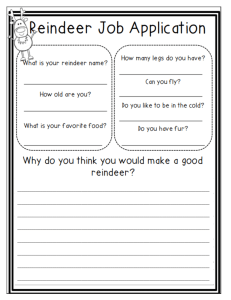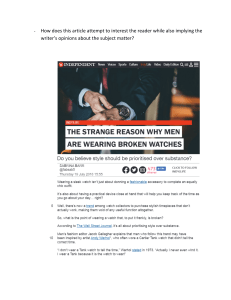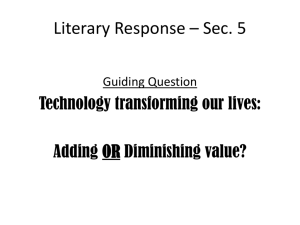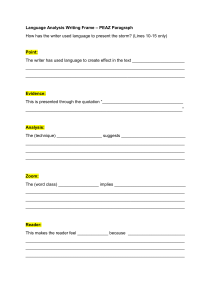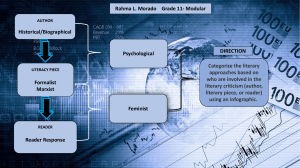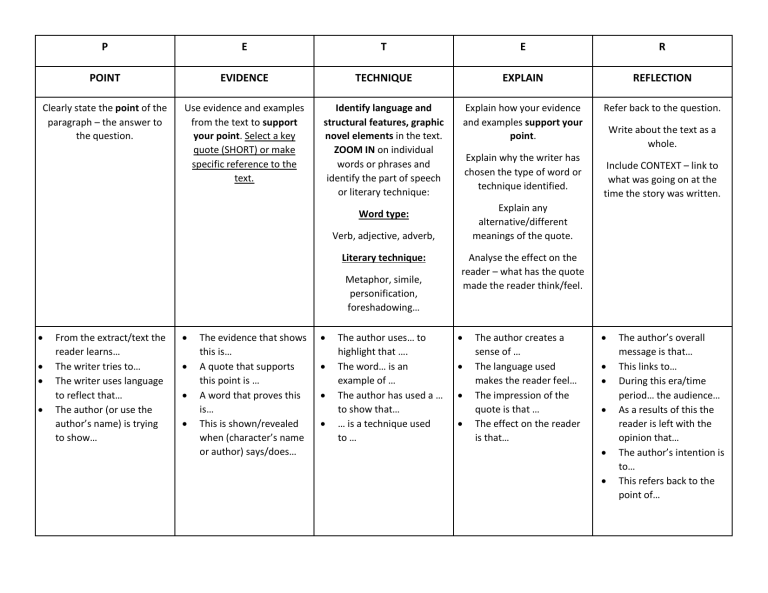
P E T E R POINT EVIDENCE TECHNIQUE EXPLAIN REFLECTION Clearly state the point of the paragraph – the answer to the question. Use evidence and examples from the text to support your point. Select a key quote (SHORT) or make specific reference to the text. Identify language and structural features, graphic novel elements in the text. ZOOM IN on individual words or phrases and identify the part of speech or literary technique: Explain how your evidence and examples support your point. Refer back to the question. Explain why the writer has chosen the type of word or technique identified. Explain any alternative/different meanings of the quote. Word type: Verb, adjective, adverb, Literary technique: Metaphor, simile, personification, foreshadowing… • • • • From the extract/text the reader learns… The writer tries to… The writer uses language to reflect that… The author (or use the author’s name) is trying to show… • • • • The evidence that shows this is… A quote that supports this point is … A word that proves this is… This is shown/revealed when (character’s name or author) says/does… • • • • The author uses… to highlight that …. The word… is an example of … The author has used a … to show that… … is a technique used to … Write about the text as a whole. Include CONTEXT – link to what was going on at the time the story was written. Analyse the effect on the reader – what has the quote made the reader think/feel. • • • • The author creates a sense of … The language used makes the reader feel… The impression of the quote is that … The effect on the reader is that… • • • • • • The author’s overall message is that… This links to… During this era/time period… the audience… As a results of this the reader is left with the opinion that… The author’s intention is to… This refers back to the point of… How to write about context in your literary analysis essays – 3 guiding questions To incorporate contextual links in your literary analysis, I’ve come up with 3 guiding questions you can consider to navigate the process: 1. Given what I know about the historical background of the work, what are some similar events, characters or patterns between the text and the time when the author was writing the text? 2. Given the socio-political and/or economic conditions of the author’s context, what would a person similar to the character in the text most likely do, think or feel in that sort of environment? 3. Why would the author be so influenced or impacted by what was going on around her to want to write a creative work about it? What is the historical significance of those events? In this extract the creature is trying to get Victor to listen to him and is trying to understand why Victor treated him so badly. He begins by telling Victor that he was, ‘benevolent and good’ and that ‘misery made (him) a fiend’ (pg55) . This reveals that when the creature was first “born” he was ready to accept and return any love shown to him. The personified use of ‘misery’ suggests that he perceived himself as human and did not anticipate the prejudice he would suffer or the effect it would have on him. His hurt and confusion is further emphasised by the use of irregular yellow speech bubbles which highlight the differences between him and Victor. This contrast in the monster’s character can be linked to Rousseau’s theory that people are born good but are made evil by the influence of society. The reader feels sympathy for the monster because he was born innocent and ‘good’ but made evil and a ‘fiend’ by society and Frankenstein’s abandonment. PETE(C)R
